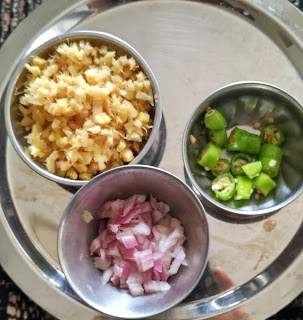Brown Peas are obtained from cowpeas (Lobia). It is sold as Red Lobia /Lobia in markets. In malayalam it is known as Vanpayar.
It contains high protein and high fiber. So when consumed it keeps hunger pangs away. Hence good for weight loss. It contains antioxidants and flavanoids. So it has anti-aging properties and is also good for the health of the heart. It will keep your cholesterol under check. Good for pregnant women as it contains iron, folate and protiens. Consumption of lobia by the pregnant mothers prevents birth defects in babies. Good for the digestive system as it contains high fiber. Good for diabetics.
Preparation:
- Soak the brown peas in water for an hour.
- Grind the soaked brown peas, ginger- garlic paste, fennel seeds, fish masala, chopped onion, red chilly powder and garam masala into a coarse mixture.
- Take a piece of banana leaf / Aluminium foil of dimension 6'' X 12". Wash and dry the banana leaf with a towel. Apply oil on the leaf lightly.
- Spread out the ground mix evenly over the leaf or aluminium foil and fold in half.
- Steam this for 20 minutes.
- Allow to cool. Remove the leaf /foil.
- Cut this into small or big pieces, according to your preference.
- Keep a flat tawa on the flame. Pour little oil and spread it out.
- Shallow fry the pieces till crispy, on both sides.(If you like, you can apply fish fry masala on the pieces before shallow frying.)
- If you want it crispier, dip the pieces in bread crumbs and deep fry. I just shallow fried and it was crispy enough for me.
- Serve as snack with a dip of your choice or as a side dish with rice.
Ingredients:
Brown peas (dry) - 1/2 cup
Ginger-garlic paste - 3 teaspoons
Fennel seeds - 1/2 tablespoon
Fish masala - 3 teaspoons
Red chilly powder - 1 - 2 teaspoons (or according to ones preference)
Garam masala - 1 teaspoon
Onion - 1 small
Oil - 2 tablespoons
Fish fry masala - 2 teaspoons (optional)
Bread crumbs - 1/2 cup (optional)
Oil - 11/2 - 2 cups (for deep frying) (optional)
*Note : No salt is required in this recipe.












